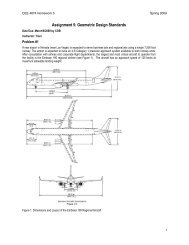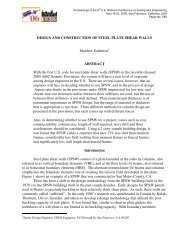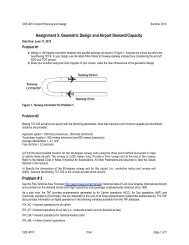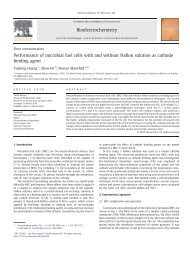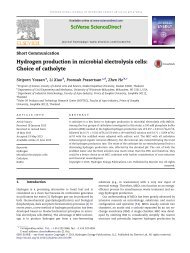Environmental Science & TechnologyArticleFigure 3. Pr<strong>of</strong>iles <strong>of</strong> current generation during the operating period:(A) MFC-AC and (B) MFC-Pt.period <strong>of</strong> time, were mostly because the tubing cloggingstopped the supply <strong>of</strong> the primary effluent (or the anodeemptiness test). We expect that the tube clogging can beovercome in a larger scale MFC system, which will have a muchfaster feeding flow rate. The gradual decrease in the currentafter day 400 was due to the decreasing temperature (seeFigure S2 <strong>of</strong> the Supporting Information). Bi<strong>of</strong>ouling <strong>of</strong> bothmembrane and cathode electrode over time might alsocontribute to the decreasing current. In general, there wasnot an obvious difference in current generation between thetwo MFCs, both <strong>of</strong> which achieved similar CEs and CRs (seeTable S1 <strong>of</strong> the Supporting Information), suggesting thatactivated carbon (AC) powder can be an effective catalyst in aMFC. 22 However, we do not think that AC powder is goodenough to replace platinum in any other oxygen-reductionprocesses, such as conventional hydrogen fuel cells. Therelatively comparable performance that AC powder achieved ina MFC is likely due to the low demand <strong>of</strong> oxygen reduction;that is, platinum is “overqualified” to be a catalyst for MFCs.The low Pt loading rate on the cathode electrode might also beone <strong>of</strong> the reasons why the MFC-Pt did not outperform theMFC-AC. Nevertheless, the cathode catalyst is not the focus <strong>of</strong>this study, and our results show that AC powder could be analternative catalyst for further MFC development.Energy production is a key parameter to properly evaluatethe benefits <strong>of</strong> MFC technology for wastewater treatment. 14We analyzed energy production and consumption andestablished a preliminary energy balance (Table 1). Energyproduction was expressed as kilowatt hours per cubic meter <strong>of</strong>treated wastewater or kilogram <strong>of</strong> removed COD (eitherTCOD or SCOD). Energy consumption included theconsumption by pumps for feeding and recirculation; thefeeding energy could be neglected in comparison to therecirculation energy. The two MFCs produced comparableelectric energy but had different energy consumption, mainlybecause <strong>of</strong> the difference in hydraulic head loss, which is a keyelement in estimating energy consumption (details in theSupporting Information). The measured hydraulic head loss <strong>of</strong>Table 1. Summary <strong>of</strong> Energy Production and Consumption in the MFCs aenergy production energy consumption energy balancekWh/m 3 kWh/kg <strong>of</strong> TCOD kWh/kg <strong>of</strong> SCOD kWh/m 3 kWh/kg <strong>of</strong> TCOD kWh/kg <strong>of</strong> SCOD kWh/m 3 kWh/kg <strong>of</strong> TCOD kWh/kg <strong>of</strong> SCODMFC-AC 0.0255 (0.0204) 0.0794 (0.1015) 0.1702 (0.2433) 0.0238 (0.0045) 0.0761 (0.0748) 0.1698 (0.1915) 0.0017 (0.0248) 0.0034 (0.1763) 0.0004 (0.4348)MFC-Pt 0.0239 (0.0186) 0.0739 (0.0653) 0.1643 (0.1792) 0.0147 (0.0004) 0.0547 (0.0473) 0.1462 (0.2206) 0.0092 (0.0190) 0.0192 (0.1127) 0.0181 (0.3998)N-MFC b 0.0078 (0.0059) 0.0236 (0.0195) 0.0391 (0.0287) 0.0238 (0.0045) 0.0769 (0.0293) 0.1746 (0.1442) −0.0160 (0.0104) −0.0532 (0.0488) −0.1356 (0.1729)a The values in parentheses are standard deviations.b The MFC system for nitrogen removal consisted <strong>of</strong> the MFC-AC and a denitrifying MFC.4944dx.doi.org/10.1021/es400631r | Environ. Sci. Technol. 2013, 47, 4941−4948
Environmental Science & Technologythe anode recirculation pump for the MFC-AC was 19.0 ± 6.1cm, significantly higher than 6.7 ± 0.6 cm with the MFC-Pt.We found that this difference was related to the size <strong>of</strong> tubingconnectors; we accidently used smaller size connectors in theMFC-AC, which resulted in a higher hydraulic head loss. Thisindicates that, in designing future MFC systems, the size <strong>of</strong>connector/port should be large enough to reduce hydraulichead loss and, thus, energy consumption. Overall, both MFCsachieved positive energy balances with large standard deviations(Table 1); the MFC-Pt had a more positive balance because <strong>of</strong>less energy consumption.For practical application, it is important to have durable andstable treatment technology, which is related to themaintenance and operating expense. A potential concern withusing the anode effluent as a catholyte is the overgrowth <strong>of</strong>bi<strong>of</strong>ilm on the cathode electrode stimulated by the remainingorganics/nitrogen in the anode effluent. During the operation,bi<strong>of</strong>ilm formed on the cathode electrode and possiblyfunctioned as post-treatment <strong>of</strong> organics and nitrogen;however, we did not clean the cathode electrode during theentire experimental period. This suggests that bi<strong>of</strong>ilm formationwas not as serious as expected and did not significantly affectelectricity generation. We also examined the response <strong>of</strong> theMFCs to fluctuation under two conditions. The first conditionwas to mimic a situation in which the anode compartmentswere emptied for repair or other maintenance; in this case,oxygen enters the anode compartment after the water wasemptied. The emptiness was held for 3, 2, and 1 day, and weobserved that the current generation in the two MFCsrecovered from oxygen intrusion in a few days, dependingupon the length <strong>of</strong> the exposure (Figure 4A). Thisdemonstrates that the MFCs could successfully handle oxygenflux for a short period <strong>of</strong> time, likely benefiting from facultativemicroorganisms in the anode community. The secondcondition was to simulate a larger water flux for a short periodin the case <strong>of</strong> rain or storm. The large water flux alters theanolyte HRT, and thus, we examined three HRTs: 12 h, 6 h,and 3 h. The amount <strong>of</strong> the wastewater at a HRT <strong>of</strong> 3 h was 4times greater that at 12 h, higher than common ratios <strong>of</strong> thetreatment capacities between dry and wet weather. TCODremoval decreased with the decreasing HRTs in both MFCs,because <strong>of</strong> a higher organic loading rate at a smaller HRT(Figure 4B). The current generation in the MFC-AC slightlydecreased, but the MFC-Pt had a more significant drop in itscurrent at shorter HRTs (the inset <strong>of</strong> Figure 4B), which mightbe attributed to Pt catalyst contamination by serious bi<strong>of</strong>oulingfrom more organic input, but the exact reason is not clear atthis moment. Both MFCs recovered to regular performanceafter the HRT was adjusted back to 12 h. We are moreoptimistic about the COD removal during shorter HRTs andexpect much higher removal efficiencies than those shown inFigure 4B, because rainwater will greatly dilute the COD andthe actual organic loading rate may not increase significantly.Nitrogen Removal. Nitrogen removal is <strong>of</strong> great interest inwastewater treatment because <strong>of</strong> the tightened regulations onnitrogen discharge. Ammonia cannot be effectively oxidizedunder the anaerobic condition <strong>of</strong> the anode <strong>of</strong> a MFC; 23however, it was found that nitrate can be bioelectrochemicallyreduced on the cathode by accepting electrons from a cathodeelectrode. 24 In the cathode <strong>of</strong> the present MFCs, nitrate wasproduced and accumulated and ammonium was reduced to avery low level (see Figures S5 and S7 <strong>of</strong> the SupportingInformation ), indicating the occurrence <strong>of</strong> nitrification. The4945ArticleFigure 4. MFC performance in response to fluctuation: (A) emptyingthe anode for different periods and (B) different HRTs (bars representTCOD removal and dots/lines represent current density).concentration <strong>of</strong> total nitrogen in the final effluent (from thecathode) was dominated by the nitrate concentration; therefore,to improve the removal <strong>of</strong> total nitrogen, we connected adenitrifying MFC for nitrate reduction to the MFC-AC on day301.Such a cooperative system between a denitrifying MFC and aregular MFC (as shown by the inset <strong>of</strong> Figure 5A) significantlyimproved the nitrogen removal. The concentration <strong>of</strong> nitratewas reduced from 21.4 ± 10.2 mg/L in the cathode effluent <strong>of</strong>the MFC-AC to 4.9 ± 3.8 mg/L in the cathode effluent <strong>of</strong> thedenitrifying MFC (also the final effluent <strong>of</strong> the MFCtreatment), about a 77% reduction (Figure 5B). The averagecurrent <strong>of</strong> the denitrifying MFC was about 8.6 mA, resulting ina CE <strong>of</strong> 14.3% based on nitrate removal, which was lower thanthose obtained in our previous studies. 25,26 The total nitrogen(sum <strong>of</strong> TKN, nitrate, and nitrite) was reduced by 76.2%, muchhigher than 27.1% without the denitrifying MFC. As expected,the ammonium or TKN concentrations were not obviouslyaffected by the denitrifying cathode (panels A and B <strong>of</strong> Figure5), and some loss <strong>of</strong> ammonium or TKN in the anodes <strong>of</strong> theMFCs was likely due to ammonium ion movement throughCEM 27 and microbial synthesis. The denitrifying MFC alsoremoved 31.8 ± 23.2% TCOD or 38.3 ± 15.3% SCOD.Excessive consumption <strong>of</strong> organic compounds in the anode <strong>of</strong>the denitrifying MFC was not desired, because it would reduceenergy production in the MFC-AC and result in a negativeenergy balance (Table 1); the denitrifying MFC was operatedunder a high-current mode, and thus, little electric power/energy was produced.Carbon Balance. A mass balance <strong>of</strong> carbon compoundsbased on either TCOD or SCOD was established with thedx.doi.org/10.1021/es400631r | Environ. Sci. Technol. 2013, 47, 4941−4948




